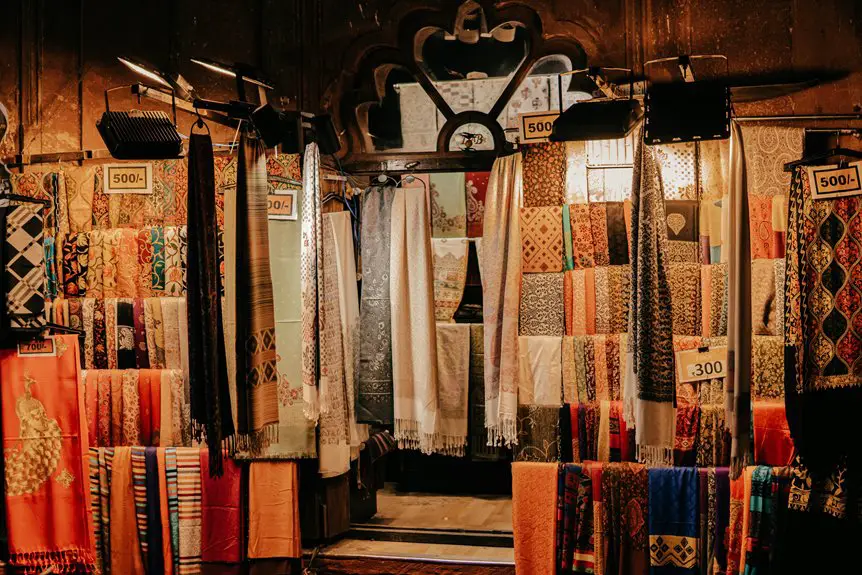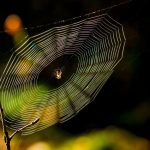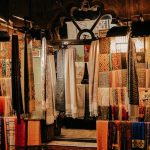Pochampally Ikat is a centuries-old silk weaving craft from India’s renowned Silk City, where skilled artisans create vibrant, geometric patterns using a unique resist dyeing technique on the yarns before weaving. This tradition blends cultural pride and intricate craftsmanship, producing soft, lustrous silk textiles cherished in Telangana and beyond. If you’re drawn to colorful heritage and timeless artistry, exploring Pochampally Ikat will reveal its rich history, cultural significance, and modern global appeal.
Table of Contents
Key Takeaways
- Pochampally Ikat is a traditional silk weaving craft from Telangana, known for its intricate double ikat dyeing technique creating vibrant geometric patterns.
- The craft reflects centuries-old cultural heritage and local pride, with patterns symbolizing folklore, nature, and significant life events.
- Artisans tie and dye silk threads before weaving, ensuring unique blurred designs and precise alignment of motifs on both warp and weft.
- Pochampally Ikat silk sarees are prized for their softness, sheen, and are integral to weddings and religious ceremonies in India.
- Modern adaptations and global demand have expanded Pochampally Ikat’s presence in fashion and home décor, preserving its authenticity and appeal.
The Historical Roots of Pochampally Ikat
Although many know Pochampally for its vibrant silk sarees, its Ikat tradition dates back centuries, rooted deeply in the region’s culture.
When you investigate Pochampally’s history, you’ll discover how this weaving art evolved as an essential part of the community’s identity. You’ll find that local weavers passed down their skills through generations, preserving unique patterns and techniques that reflect their heritage.
As you explore its past, you’ll see how trade routes influenced design styles, blending local creativity with external inspirations. This rich historical backdrop not only shaped the aesthetic appeal but also established Pochampally Ikat as a symbol of craftsmanship and cultural pride.
When you wear or admire these fabrics, you’re connecting with a legacy that’s stood the test of time.
Understanding the Ikat Dyeing Technique
You’ll find that the Ikat weaving process starts with carefully tying sections of yarn to resist dye in specific patterns.
This resist dyeing technique creates the unique, blurred designs Pochampally Ikat is famous for.
Understanding how these patterns form gives you a deeper appreciation for the skill behind each piece.
Ikat Weaving Process
Discover how the intricate Ikat dyeing technique transforms threads into vibrant patterns before the weaving even begins.
Once the threads are dyed, you’ll see the true magic of the Ikat weaving process unfold. You carefully align these dyed threads on the loom, ensuring the pre-dyed motifs match perfectly. As you weave, the patterns emerge slowly but surely, creating mesmerizing designs unique to each piece.
Here’s how you’ll experience the process:
- Preparing the warp and weft threads with precision to maintain pattern accuracy.
- Setting up the loom, where each thread’s position is essential for design clarity.
- Weaving the fabric patiently, watching the vibrant Ikat patterns come alive with every pass of the shuttle.
This process demands skill and attention, turning dyed threads into stunning textiles.
Resist Dyeing Explained
When you plunge into the resist dyeing process, you’ll see how skilled artisans tie and bind specific sections of threads to resist dye penetration. This technique allows them to create intricate patterns on yarn before weaving. By carefully tying knots, they control where the dye colors the threads, producing the signature blurred edges of Ikat designs. The process repeats with multiple dye baths for multicolor effects.
| Step | Action | Purpose |
|---|---|---|
| 1. Thread tying | Bind thread sections | Resist dye in tied areas |
| 2. Dyeing | Dip threads in dye | Color untied sections |
| 3. Drying | Air dry dyed threads | Fix dye before next step |
| 4. Repeat | Tie & dye again | Add layers of color and detail |
Pattern Formation Techniques
Mastering the resist dyeing process sets the stage for understanding how intricate Ikat patterns come to life. In Pochampally Ikat, you manipulate threads before weaving, creating designs that appear woven into the fabric itself.
Here’s how the pattern formation unfolds:
- Thread Alignment: You carefully align dyed threads on the loom, ensuring the pre-dyed patterns match perfectly.
- Multiple Resist Applications: You bind sections of threads repeatedly, applying resist multiple times to achieve complex, multi-colored motifs.
- Weaving Precision: As you weave, the aligned threads form vibrant geometric and floral patterns, revealing the artistry behind every piece.
This meticulous technique gives Pochampally Ikat its signature blurred edges and stunning depth, showcasing the craftsmanship woven into each fabric.
Unique Patterns and Motifs of Pochampally Ikat
You’ll notice Pochampally Ikat stands out with its bold geometric designs that create striking visual effects.
Each pattern carries traditional symbolism, reflecting local culture and beliefs.
Understanding these motifs helps you appreciate the artistry woven into every piece.
Geometric Designs Explained
Geometric designs form the heart of Pochampally Ikat, fascinating you with their sharp lines and balanced shapes.
When you explore these patterns, you’ll notice how each motif brings a rhythmic harmony to the fabric, creating a visual dance that’s both bold and elegant.
Here’s what you’ll find:
- Diamond shapes – These interlocking diamonds symbolize unity and continuity, drawing your eye with their crisp edges.
- Triangles and chevrons – Pointing in various directions, they add dynamic movement and depth.
- Stripes and zigzags – These repetitive patterns create texture and contrast, highlighting the skill in the weaving process.
Each element combines to make Pochampally Ikat’s geometric designs truly fascinating and distinct.
Traditional Symbolism Meaning
Symbols and motifs in Pochampally Ikat carry deep meanings that connect you to the region’s rich cultural heritage. When you explore these patterns, you’ll notice recurring shapes like diamonds, squares, and zigzags, each symbolizing protection, fertility, and prosperity.
Floral motifs represent nature’s bounty, while geometric precision reflects harmony and balance in life. These designs aren’t random; they tell stories passed down through generations.
By wearing or appreciating Pochampally Ikat, you participate in a tradition that honors community values and spiritual beliefs. Each motif you see is a link to the artisans’ intentions and the cultural significance embedded in every thread.
This makes Pochampally Ikat more than fabric—it’s a vibrant expression of identity and history.
The Role of Silk in Pochampally’s Textile Tradition
Although cotton has its place, silk holds a special significance in Pochampally’s textile tradition. When you explore Pochampally Ikat, you’ll notice how silk elevates the fabric’s elegance and durability. This luxurious fiber transforms every piece into a masterpiece, cherished for its softness and sheen.
As you dive deeper, imagine:
- Threads of shimmering silk tightly woven, reflecting sunlight with every movement.
- Artisans skillfully dyeing silk yarns in vibrant colors, ready to create intricate Ikat patterns.
- Finished silk sarees draped gracefully, their lustrous texture enchanting onlookers at festivals and ceremonies.
Silk’s role here isn’t just functional—it’s a symbol of cultural pride, weaving tradition into every thread you touch or wear.
The Artisans Behind the Craft
Behind every exquisite Pochampally Ikat saree, skilled artisans pour their years of experience and passion into each thread.
You’ll find these craftsmen and craftswomen mastering a unique double ikat technique, which requires precise tie-dyeing of both warp and weft yarns before weaving.
You can appreciate their patience as they meticulously plan intricate geometric patterns, ensuring perfect alignment during weaving.
When you watch them work, you’ll notice their deep understanding of color blending and fabric tension, vital for the final design’s clarity.
These artisans often inherit their skills through generations, blending tradition with subtle innovation.
Cultural Significance in Telangana and Beyond
The artistry of Pochampally Ikat goes beyond craftsmanship; it carries deep cultural meaning in Telangana and across India. When you wear or see this fabric, you connect with centuries of tradition and identity. Its patterns symbolize unity and harmony within communities, reflecting the region’s heritage.
You’ll notice how it marks important life events and festivals, making it more than just clothing.
Here’s what makes Pochampally Ikat culturally significant:
- It embodies Telangana’s history and local pride through unique geometric motifs.
- It plays a key role in weddings and religious ceremonies, symbolizing blessings and prosperity.
- It acts as a visual storyteller, preserving folklore and ancestral tales in its intricate designs.
This fabric truly weaves culture into every thread you touch or admire.
Modern Adaptations and Global Influence
While rooted in tradition, Pochampally Ikat has evolved to fit modern tastes and global markets. You’ll find designers blending classic patterns with contemporary styles, making the fabric popular in fashion and home décor worldwide. This evolution keeps the craft alive and relevant.
| Adaptation | Description | Global Impact |
|---|---|---|
| Fashion Fusion | Combining Ikat with modern cuts | Popular in international runways |
| Sustainable Use | Eco-friendly dyes and materials | Appeals to conscious consumers |
| Digital Prints | Incorporating traditional motifs | Expands design versatility |
| Home Décor | Cushions, curtains, upholstery | Introduces Ikat to new markets |
| Collaborations | Artisan-designer partnerships | Boosts cultural exchange |
You can see how Pochampally Ikat transcends boundaries while honoring its heritage.
How to Identify Authentic Pochampally Ikat
When you want to spot authentic Pochampally Ikat, focus on the intricate tie-dye patterns created through a unique double ikat weaving technique. This method guarantees the design is perfectly aligned on both the warp and weft threads.
To identify genuine Pochampally Ikat, keep these points in mind:
- Pattern precision – Look for sharp, symmetrical motifs with clear edges; blurry or uneven designs usually mean machine-made or fake.
- Color vibrancy – Authentic Ikat uses natural or high-quality dyes, resulting in rich, lasting colors that don’t fade easily.
- Handwoven texture – Feel the fabric; handcrafted Ikat has slight irregularities and a soft, sturdy texture that machine-made fabrics lack.
Frequently Asked Questions
What Tools Are Essential for Making Pochampally Ikat?
You’ll need a wooden loom, tie-dye materials, and resist-dyeing tools like threads and wax for making Pochampally Ikat. These help you create the intricate, geometric patterns unique to this traditional weaving technique.
How Long Does It Take to Complete One Pochampally Ikat Saree?
You’ll spend about 15 to 20 days completing one Pochampally Ikat saree. The intricate dyeing and weaving process demands patience and precision to create the beautiful, unique patterns you’ll admire.
Are There Specific Seasons Best for Weaving Pochampally Ikat?
Imagine weaving Pochampally Ikat in a medieval guild hall; you’ll find the best seasons are post-monsoon and winter when humidity’s low, protecting silk threads. You’ll work comfortably, ensuring vibrant, flawless patterns emerge on each saree.
What Care Instructions Preserve Pochampally Ikat Fabric Longevity?
You should hand wash Pochampally Ikat in cold water with mild detergent, avoid wringing, and dry it in shade. Iron it on low heat to preserve the fabric’s vibrant colors and intricate patterns for years.
Can Pochampally Ikat Designs Be Customized for Modern Fashion?
They say, “Variety is the spice of life.” You can absolutely customize Pochampally Ikat designs for modern fashion, blending traditional patterns with contemporary styles to create unique, trendy outfits that reflect your personal taste.
- How Batching Time and Temperature Affect Tie-Dye - July 14, 2025
- The “Wet Powder on Dry Fabric” Tie-Dye Technique - July 14, 2025
- The “Dry Powder on Wet Fabric” Tie-Dye Technique - July 14, 2025






